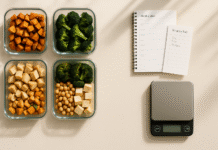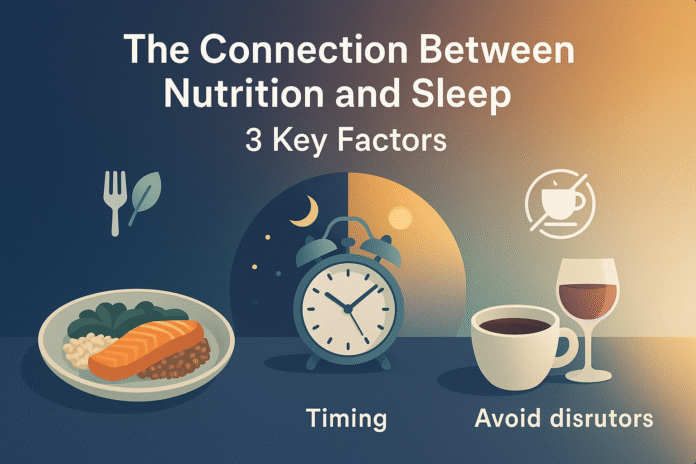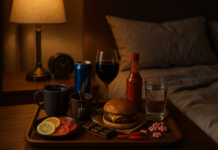Good sleep doesn’t just start in the bedroom—it starts in the kitchen. The connection between nutrition and sleep runs through your metabolism, your body clock, and the brain chemicals that make you feel sleepy or alert. In this guide, you’ll learn how what you eat, when you eat, and what you avoid can add up to steadier energy in the day and deeper sleep at night. Whether you’re a busy professional, a student fighting late-night cravings, or someone troubleshooting stubborn insomnia, these nutrition strategies will help you build a more sleep-friendly routine without fancy products or fads.
Medical disclaimer: This article offers general education, not medical advice. If you have ongoing sleep problems, a chronic health condition, or take medications, consult a qualified health professional for personalized guidance.
Key takeaways
- What you eat matters: Diets richer in fiber and certain amino acids and minerals are linked with more restorative sleep. Focus on whole foods, adequate protein, and balanced carbs and fats.
- When you eat matters: Timing meals earlier—especially your largest one—and keeping a consistent pattern may support your circadian rhythm and make falling asleep easier.
- What you avoid matters: Caffeine, alcohol, nicotine, oversized late meals, and heavy evening fluids can fragment sleep or delay sleep onset. Manage dose and cut-off times.
- Start small, track results: Measure a few basics (sleep onset latency, nighttime awakenings, caffeine milligrams, “last meal” time) and adjust week by week.
- Progress beats perfection: You don’t need a perfect diet to sleep better. Tiny, consistent tweaks to food quality, timing, and stimulants go a long way.
Factor 1: What You Eat — Nutrient Quality and the Brain Chemicals of Sleep
What it is & why it helps
Your brain can only make sleep-related neurotransmitters (like serotonin and melatonin) from what you put on your plate. At a high level, three nutrition levers influence sleep quality:
- Amino acids (especially tryptophan) that serve as building blocks for serotonin and melatonin.
- Dietary patterns higher in fiber and lower in saturated fat and added sugars, which are associated with more deep, restorative sleep and fewer awakenings.
- Key micronutrients—notably magnesium and iron—that support relaxation, nerve signaling, and movement control.
Requirements & low-cost alternatives
- No special equipment beyond basic cookware.
- Grocery staples: eggs, dairy or fortified alternatives, legumes, nuts/seeds, fish or tofu/tempeh, whole grains, fruits, vegetables, and olive oil.
- Budget tip: Buy frozen vegetables and fruits; choose dry beans and lentils; pick canned fish; prioritize store-brand whole grains.
Step-by-step: Build a sleep-supportive plate (beginner-friendly)
- Anchor each meal with protein (15–35 g): eggs, Greek yogurt, cottage cheese, tofu/tempeh, legumes, fish, or poultry. These provide tryptophan and stabilize energy.
- Add high-fiber carbs: oats, quinoa, brown rice, whole-grain bread, beans, lentils, fruit, and root veg. Fiber correlates with more slow-wave (deep) sleep and fewer arousals.
- Include healthy fats: olive oil, avocado, nuts, seeds. Fats slow gastric emptying and steady blood sugar—use moderate portions, aiming to limit saturated fat.
- Micronutrient awareness:
- Magnesium: find it in pumpkin seeds, almonds, cashews, black beans, edamame, and leafy greens.
- Iron: red meat, poultry, fish; plant sources (lentils, spinach) + vitamin C (citrus, peppers) to aid absorption—especially relevant if you struggle with restless legs.
- Vitamin D: fatty fish, eggs, fortified dairy/plant milks; sunlight exposure helps too.
- Flavor without reflux triggers: if spicy or acidic foods disturb your sleep, lean into herbs, ginger, garlic, and low-acid sauces at dinner.
Beginner modifications & progressions
- If you rarely cook: Start with one “sleep plate” per day—e.g., lentil soup + whole-grain toast + side salad.
- If you snack at night: Pre-portion a simple option such as Greek yogurt with banana and a sprinkle of oats, or a small glass of milk and a few almonds.
- If you already eat whole foods: Fine-tune fiber (25–38 g/day depending on body size), swap saturated fats (butter, fatty cuts) for olive oil and nuts, and check iron and magnesium variety.
Recommended frequency, duration, and metrics
- Daily practice: 2–3 balanced meals + 0–1 planned snack if needed.
- Metrics to track (3–4 weeks):
- Sleep onset latency (minutes to fall asleep).
- Night awakenings and “wake after sleep onset” (WASO).
- Average fiber grams/day.
- % of calories from saturated fat.
- Presence of a tryptophan-containing protein in your evening meal/snack.
Safety, caveats, and common mistakes
- Don’t overpromise on single foods or supplements. Whole-diet patterns matter more than any one “sleep superfood.” Evidence for some supplements (e.g., vitamin D or magnesium) is mixed—use food-first, and talk with your clinician if you consider a supplement.
- Iron caution: Supplementing iron without testing can be harmful. If you suspect deficiency or restless legs, get ferritin checked and follow medical advice.
- Reflux awareness: If you struggle with heartburn, avoid heavy, greasy, or very spicy dinners close to bedtime.
Sample mini-plan (evening)
- Dinner (3–4 hours before bed): Salmon (or baked tofu), quinoa, roasted vegetables, and olive-oil–lemon drizzle.
- Optional snack (60–120 minutes before bed if hungry): Plain yogurt with sliced kiwi or banana, or warm milk with oats and a pinch of cinnamon.
Factor 2: When You Eat — Chrononutrition & Meal Timing
What it is & why it helps
Your body runs on circadian rhythms. Eating at consistent times—especially earlier in the day—can align digestion, hormones, and body temperature with your sleep-wake cycle. Two principles are particularly relevant:
- Front-load your calories and finish larger meals earlier.
- Create a clear “kitchen curfew.” Leaving a buffer between your last meal and bedtime supports melatonin rise, reduces reflux risk, and may shorten the time it takes to fall asleep.
There’s also intriguing (and evolving) research around time-restricted eating (TRE). While TRE can help some people consolidate eating windows, sleep improvements are inconsistent across studies. You don’t need to fast to benefit; a simple, regular meal schedule and a consistent “last bite” time can be enough.
Requirements & low-cost alternatives
- None. A clock, a rough schedule, and a bit of planning. If life is unpredictable, aim for patterns rather than precise times.
Step-by-step: Set up a sleep-friendly eating schedule
- Pick your “kitchen curfew.” Most people do well finishing dinner 2–4 hours before bed. If you go to bed at 11:00 p.m., aim to wrap up dinner between 7:00–9:00 p.m.
- If you get hungry late: Build a planned, light snack 60–120 minutes before bed (protein + easy-to-digest carb), rather than random grazing.
- Keep daytime meals consistent: Try not to swing wildly between skipping and feasting. Even a small, protein-containing breakfast can stabilize appetite and reduce nighttime cravings.
- Experiment, then lock it in: Adjust your curfew by 30-minute increments for 1–2 weeks and note effects on sleep onset and awakenings.
Beginner modifications & progressions
- If evenings are hectic: Batch-cook a simple dinner (e.g., sheet-pan chicken/tofu + veg) so you can finish eating earlier.
- If you work shifts: Align your “largest meal” with the start of your active period and keep a 2–4 hour gap before intended sleep, regardless of clock time.
- If you already time meals well: Test a high-fiber, moderate-carb dinner (or, for some people, a higher-GI carb component 3–4 hours pre-bed) and compare sleep onset.
Recommended frequency, duration, and metrics
- Daily practice.
- Metrics to track (3–4 weeks):
- Time of last meal or snack.
- Minutes from last bite to lights out.
- Sleep onset latency and reflux symptoms (if any).
- Consistency score: How many days this week did you keep a 2–4 hour buffer?
Safety, caveats, and common mistakes
- Don’t go to bed starving. Low blood sugar can cause awakenings. Use a small, balanced snack if needed.
- Be reflux-smart. Large or spicy meals late in the evening can provoke heartburn and wake-ups.
- TRE expectations: Sleep benefits vary. If a shorter eating window worsens your sleep or raises stress, loosen it.
Sample mini-plan (timing)
- Finish dinner by 8:00 p.m. for an 11:00 p.m. bedtime.
- If needed at 9:30–10:00 p.m.: small snack (e.g., warm milk + 2–3 plain crackers or yogurt + banana).
Factor 3: What You Avoid — Caffeine, Alcohol, Nicotine, Sugar Surges, and Late Fluids
What it is & why it helps
Some substances boost alertness or fragment sleep long after you’ve consumed them. Managing dose and timing—rather than complete abstinence—often unlocks better nights.
- Caffeine: Even afternoon doses can delay sleep and reduce total sleep time.
- Alcohol: It may speed sleep onset but tends to fragment sleep and alter normal sleep architecture later in the night.
- Nicotine: A stimulant that lengthens sleep onset latency and increases awakenings.
- Late fluids and extra-large meals: Raise the odds of nocturia (nighttime bathroom trips) and reflux, which can repeatedly wake you.
Requirements & low-cost alternatives
- No special tools—just choose cut-off times and substitute options: decaf coffee/tea, herbal infusions, sparkling water, alcohol-free options, smaller evening portions.
Step-by-step: Dial back common sleep disruptors
- Set a caffeine cut-off. Choose a time at least 6–8 hours before bed for your last caffeinated drink. Track total daily caffeine (many people aim for ≤400 mg/day if not pregnant or sensitive).
- Right-size alcohol intake. If you drink, keep it light and avoid in the 3–4 hours before bed. Observe your sleep—many notice more awakenings and lighter sleep after drinking.
- Mind nicotine timing. If you use nicotine, avoid it close to bedtime and during night awakenings. Seek help for reduction or cessation—it can dramatically improve sleep stability.
- Tame late-night reflux and bathroom trips. Finish large meals earlier; reduce fluids in the last 2–3 hours before sleep; avoid personally triggering foods in the evening.
Beginner modifications & progressions
- Sensitive to caffeine? Move your cut-off earlier by 60–120 minutes for two weeks.
- If you like a nightcap: Try an alcohol-free beverage ritual (herbal tea, sparkling water with citrus) and pair it with a relaxing routine so you don’t miss the habit.
- If nocturia wakes you: Front-load hydration in the morning and afternoon; sip, don’t chug, after dinner.
Recommended frequency, duration, and metrics
- Daily practice.
- Metrics to track (3–4 weeks):
- Caffeine milligrams/day and last-cup time.
- Number of alcoholic drinks and the finish time.
- Nicotine use timing (yes/no within 3 hours of bed).
- Night awakenings due to bathroom trips or reflux.
Safety, caveats, and common mistakes
- Medication interactions: Caffeine, alcohol, and nicotine can interact with medications. If you’re on prescription meds, confirm safe limits with your clinician.
- Alcohol rebound: You might fall asleep faster after drinking, but expect lighter sleep later.
- Beware hidden caffeine: Chocolate, some decaf coffees, pre-workouts, and pain meds may contain caffeine.
Sample mini-plan (evening)
- Last coffee at 2:00–3:00 p.m. for an 11:00 p.m. bedtime; switch to decaf or herbal tea afterward.
- Hydration taper: normal sips with dinner, then minimal fluids after; bathroom right before lights out.
Quick-Start Checklist
- Build one “sleep plate” today: Protein + high-fiber carbs + colorful veg + olive oil.
- Choose a kitchen curfew: Aim for a 2–4 hour buffer before bed.
- Set a caffeine cut-off: 6–8 hours before bedtime.
- Plan an evening snack (if needed): Protein + easy carb, small portion.
- Hydration plan: Front-load water during the day; taper after dinner.
- Track three numbers for a week: minutes to fall asleep, last-bite time, caffeine mg.
Troubleshooting & Common Pitfalls
“I’m starving at 10 p.m.”
- Your earlier meals may be too small on protein or fiber. Increase both at lunch and dinner. Keep a planned, light, protein-forward snack on hand.
“I keep waking with heartburn.”
- Shrink dinner portions; avoid your personal triggers (greasy/spicy/acidic) at night; leave more time between last bite and bed.
“Caffeine sneaks in.”
- Log it for 3 days. Count coffee, tea, energy drinks, pre-workouts, chocolate, and pain relievers. Move your last dose earlier.
“I tried fasting and slept worse.”
- TRE isn’t mandatory for sleep. Return to a regular schedule with a 2–4 hour pre-bed gap and adequate calories earlier in the day.
“Restless legs keep me up.”
- Bring this to your clinician. Ask about ferritin testing and iron status. Self-supplementing iron is not advised without labs.
“I still lie awake.”
- Combine nutrition updates with classic sleep hygiene: consistent wake time, morning light, wind-down routine, cool/dark room, and limiting late screens.
How to Measure Progress (Simple, DIY)
Daily (takes <2 minutes):
- Sleep onset latency: minutes from lights out to sleep.
- Night awakenings: count and total minutes awake.
- Last-bite time: clock time of final meal/snack.
- Caffeine tally: cups or mg.
Weekly roll-ups:
- Average sleep onset latency vs. previous week.
- % of days you kept a 2–4 hour pre-bed food buffer.
- Average fiber grams/day.
- % of days you stayed under your caffeine cap.
Optional tools: a paper log, a notes app, or a basic sleep tracker. Prioritize trends over perfection.
A Simple 4-Week Starter Plan
Week 1 — Awareness & anchors
- Keep your normal diet but add one sleep-supportive plate daily.
- Log last-bite time, time to fall asleep, and caffeine mg.
- Set a provisional caffeine cut-off 8 hours before bedtime.
Week 2 — Timing tune-up
- Establish a kitchen curfew (2–4 hours pre-bed).
- If you’re hungry late, pre-plan a small protein + carb snack.
- Shift any spicy/greasy dishes to lunch; choose gentle flavors at dinner.
- Taper fluids after dinner to cut down on nocturia.
Week 3 — Quality upgrade
- Raise fiber with beans, lentils, oats, whole grains, vegetables, and fruit.
- Swap saturated fat sources for olive oil, nuts, seeds, and fish.
- Ensure an evening protein source (eggs, yogurt, fish, tofu, legumes).
- Note whether deep sleep and awakenings change.
Week 4 — Personalization & polish
- Nudge meal times earlier or later by 30 minutes based on your logs.
- Fine-tune caffeine cut-off (earlier if sleep still delayed).
- If reflux or bathroom trips persist, reduce portion size and evening fluids further; add a gentle walk after dinner.
- Reassess: Which 2–3 habits moved your sleep the most? Lock those in as your new baseline.
FAQs
1) Do I need a special “sleep supplement” to get results?
No. Most people see improvements by adjusting food quality, meal timing, and stimulants. If you explore supplements, discuss them with your clinician—evidence for some (like magnesium or vitamin D) is mixed, and dosing and interactions matter.
2) Is dairy helpful or harmful for sleep?
It depends on your tolerance. Dairy foods supply protein—including tryptophan—and can fit well into an evening snack for many people. If dairy triggers reflux or discomfort, use yogurt or lactose-free options, or choose non-dairy protein like soy yogurt or tofu.
3) What’s a good pre-bed snack if I’m genuinely hungry?
A small portion that pairs protein + an easy-to-digest carb: plain yogurt with banana; a small glass of milk and a few crackers; tofu cubes with a few grapes; or cottage cheese and kiwi. Keep it light and finish 60–120 minutes before sleep.
4) Does a high-carb dinner help me sleep?
Some research suggests certain higher-GI carbohydrate meals eaten several hours before bed may shorten time to fall asleep. Results vary, and overall diet quality still matters. If you experiment, do so 3–4 hours pre-bed and observe your personal response.
5) I drink coffee only in the morning. Why am I still wired at night?
Total daily dose and your genetics, metabolism, or hormones can influence how long caffeine affects you. Try lowering the total milligrams, moving your last cup earlier, or switching to half-caf/decaf sooner.
6) Is alcohol truly bad for sleep if it makes me drowsy?
Alcohol can help you doze off but often disrupts sleep later—reducing sleep continuity and altering normal sleep stages. Many people notice more awakenings and lighter sleep after drinking, especially close to bedtime.
7) I wake to use the bathroom. How can nutrition help?
Front-load your fluids earlier in the day, taper after dinner, and limit alcohol/caffeine late. Empty your bladder before lights out. If nocturia persists, ask your clinician to review medications and underlying conditions.
8) What about spicy foods at dinner?
Some people tolerate them just fine; others get reflux and nighttime wake-ups. If you suspect a link, move spicy dishes to lunch or choose gentler seasonings at dinner.
9) Will time-restricted eating (TRE) improve my sleep?
It can consolidate routines for some, but sleep improvements are inconsistent in research. You don’t have to fast to sleep better—prioritize a consistent meal schedule and a 2–4 hour buffer before bed.
10) I have restless legs symptoms—should I change my diet?
Bring this to your clinician. Iron deficiency is linked to restless legs for many, but iron supplements aren’t safe to start blindly. Testing and targeted treatment are key.
11) Can vitamin D fix my sleep?
Evidence is mixed. If you’re deficient, addressing vitamin D may help overall health and possibly sleep quality, but it’s not a universal fix. Sunlight exposure, food sources, and medical guidance matter.
12) How fast will I notice improvements?
Many people feel changes within 1–2 weeks of consistent timing, better food quality, and stimulant management. Keep tracking; adjust one lever at a time.
Conclusion
You don’t need a perfect diet to sleep better. Focus on what you eat (whole foods, fiber, adequate protein, supportive micronutrients), when you eat (a steady schedule and a 2–4 hour buffer before bed), and what you avoid late (caffeine, alcohol, nicotine, heavy meals, and big gulps of fluid). Track a few simple metrics for a month, notice what moves the needle, and double down on those habits. Better nights are often built at breakfast and dinner.
One-line CTA: Tonight, set your kitchen curfew and plan a light, protein-forward evening snack—then watch what happens to your sleep over the next two weeks.
References
- High-glycemic-index carbohydrate meals shorten sleep onset. American Journal of Clinical Nutrition. 2007. https://pubmed.ncbi.nlm.nih.gov/17284739/
- High-glycemic-index carbohydrate meals shorten sleep onset (PDF). American Journal of Clinical Nutrition. 2007. https://ajcn.nutrition.org/article/S0002-9165%2823%2927929-0/pdf
- Fiber and Saturated Fat Are Associated with Sleep Arousals and Slow Wave Sleep. Journal of Clinical Sleep Medicine. 2016. https://pubmed.ncbi.nlm.nih.gov/26156950/
- Fiber and Saturated Fat Are Associated with Sleep Arousals and Slow Wave Sleep. Journal of Clinical Sleep Medicine. 2016. https://jcsm.aasm.org/doi/10.5664/jcsm.5384
- Sleep and Diet: Mounting Evidence of a Cyclical Relationship. Nutrients. 2021. https://pmc.ncbi.nlm.nih.gov/articles/PMC8511346/
- The Mediterranean Diet, the DASH Diet, and the MIND Diet and Sleep: A Systematic Review. Nutrients. 2024. https://pubmed.ncbi.nlm.nih.gov/39683584/
- Evening intake of alpha-lactalbumin increases plasma tryptophan availability and improves morning alertness in poor sleepers. American Journal of Clinical Nutrition. 2005. https://pubmed.ncbi.nlm.nih.gov/15883425/
- Alpha-lactalbumin and sleep: A systematic review. Journal of Sleep Research. 2024. https://onlinelibrary.wiley.com/doi/10.1111/jsr.14141
- Caffeine effects on sleep taken 0, 3, or 6 hours before going to bed. Journal of Clinical Sleep Medicine. 2013. https://pmc.ncbi.nlm.nih.gov/articles/PMC3805807/
- Caffeine effects on sleep taken 0, 3, or 6 hours before going to bed (PubMed record). Journal of Clinical Sleep Medicine. 2013. https://pubmed.ncbi.nlm.nih.gov/24235903/
- Spilling the Beans: How Much Caffeine is Too Much? U.S. Food & Drug Administration. 2024. https://www.fda.gov/consumers/consumer-updates/spilling-beans-how-much-caffeine-too-much
- Common questions and misconceptions about caffeine consumption. Frontiers in Nutrition. 2024. https://pmc.ncbi.nlm.nih.gov/articles/PMC10930107/




































